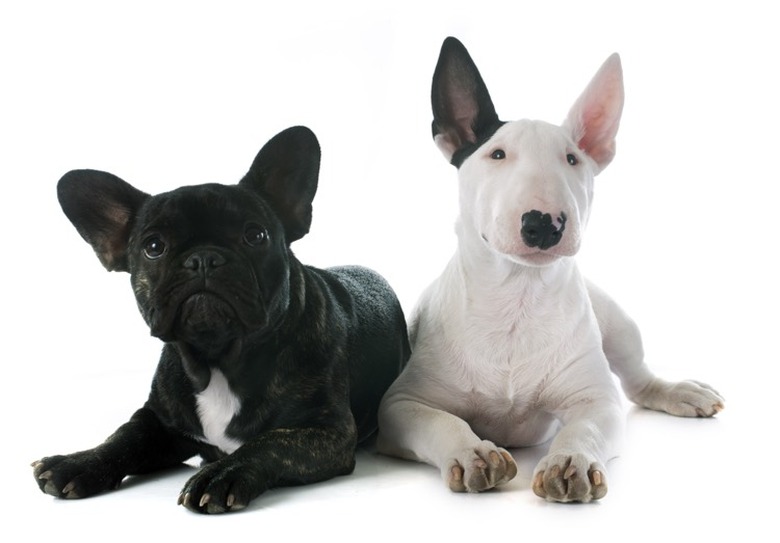Is A Bulldog A Terrier? Info On The Bull Terrier Family
The bulldog and the bull terrier have distinctive histories. The bulldog's roots trace back 500 years; the bull terrier was established in the mid 1800s. The bull terrier owes his evolution to the bulldog, but these two breeds are unique. Though they share some characteristics, the bulldog and the bull terrier parted genetic ways long ago.
Families, Orders, Subspecies and Groups
The only meaning "family" has in regards to your dog is the one he lives with, in your house. In the big scheme of things, domestic dogs are in taxonomic order Carnivora and suborder Caniformia. They're with other meat eaters, including doglike carnivores. If you want to think about the taxonomic family your dog belongs to, he's in family Canidae, joining coyotes, jackals, foxes and wolves. Domestic dogs as a whole are the subspecies Canis lupus familiaris. That means bulldogs and bull terriers are all in the same subspecies. If you want a finer distinction, the American Kennel Club categorizes dogs according to eight different groups; the bulldog is in the non-sporting group and the bull terrier is in the terrier group.
Bulldog Metamorphosis
The look of the bulldog has changed over the last 500 years to reflect how his role has changed. Long ago, he was a taller dog and was quite ferocious. Those two traits served him well in his job of bull-baiting — grabbing a bull by the nose and holding him in place to assist with castration or mating. Eventually (and unfortunately), bull-baiting became as much entertainment as function, and the dogs were gladiators in a cruel sport. England outlawed dog fighting as a sport in 1835, causing a decline in bulldog breeding. Aficionados of the breed took steps to preserve the breed, modifying it. With careful breeding, they developed a bulldog without the breed's prior vicious nature and developed the stout, low body the bulldog is now known for.
Enter the Bull Terrier
When you look at the bull terrier head-on, it's hard to see the familial resemblance to the bulldog — but the bull terrier wouldn't be the dog he is without the bulldog. In the early 1800s, people experimented with crossing bulldogs with various terriers, resulting in specimens in ranges of size, shape and color. One Englishman, James Hinks, developed the bull terrier in the early 1860s by crossing a bulldog with a white English terrier. His dogs were more polished and consistent, and sported an all white coat. The bull terrier became a popular dog beyond England in short time. In 1897, the Bull Terrier Club of America was established.
Common Threads
The enthusiasts who developed bulldogs beyond their bull-baiting ways did an amazing job: Today the bulldog is considered one of the best family dogs because he's patient, affectionate and obedient. He's especially good with children. The bull terrier has a similar disposition, though he's particularly playful. Neither of these fellows is a good yard dog, because both prefer to be with their people. Their family loyalty makes them good watchdogs, though.
Parting Ways
The bull terrier's football-shaped face bears little resemblance to that of the bulldog. His longer snout means he's not prone to the various problems that brachycephalic breeds suffer from, including conditions of the respiratory system, nose, teeth and eyes. The bulldog is more prone to skin allergies, gastric torsion and bladder stones. The bull terrier is generally a healthy breed, though patellar luxation, deafness and eye disorders can be genetic health issues. He's a more active dog than the bulldog, who is happy with a low-key walk around the block a couple times a day. The bull terrier benefits from vigorous exercise and consistent training to keep him from becoming aggressive toward strangers.
By Betty Lewis
References
Vet Street: Bull Terrier
American Kennel Club: Get to Know the Bulldog
Vet Street: Bulldog
American Kennel Club: Get to Know the Bull Terrier
PetMD: Bulldog
PetMD: Bull Terrier
Integrated Taxonomic Information System: Canis Lupus Familiaris Linnaeus, 1758
About the Author
Betty Lewis has been writing professionally since 2000, specializing in animal care and issues, business analysis and homeland security. Lewis holds a bachelor's degree in journalism from West Virginia University as well as master's degrees from Old Dominion University and Tulane University.
